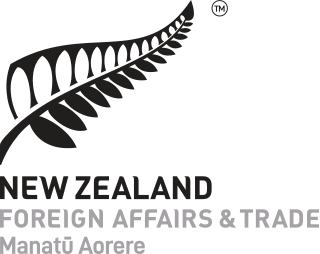Related Research Articles

Foreign relations of Australia are influenced by its position as a leading trading nation and as a significant donor of humanitarian aid. Australia's foreign policy is guided by a commitment to multilateralism and regionalism, as well as to build strong bilateral relations with its allies. Key concerns include free trade, terrorism, refugees, economic co-operation with Asia and stability in the Indo-Pacific. Australia is active in the United Nations and the Commonwealth of Nations. Given its history of starting and supporting important regional and global initiatives, it has been described as a regional middle power par excellence.
Global Affairs Canada is the department of the Government of Canada that manages Canada's diplomatic and consular relations, promotes Canadian international trade, and leads Canada's international development and humanitarian assistance. It is also responsible for maintaining Canadian government offices abroad with diplomatic and consular status on behalf of all government departments.

The Department of Foreign Affairs and Trade (DFAT) is the department of the Australian federal government responsible for foreign policy and relations, international aid, consular services and trade and investment. In 2021, DFAT allocated USD 3.4 billion of official development assistance, equivalent to 0.22% of gross national income.

The Ministry of Foreign Affairs and Trade (MFAT) (Māori: Manatū Aorere) is the public service department of New Zealand charged with advising the government on foreign and trade policy, and promoting New Zealand's interests in trade and international relations.

The China–Australia Free Trade Agreement (ChAFTA) is a bilateral Free Trade Agreement (FTA) between the governments of Australia and China. Since negotiations began, 21 negotiating rounds have been completed. The deal was completed on 17 November 2014 and details released two days later, nearly 10 years after its first round of negotiations that began on 23 May 2005 after a joint feasibility study. The free trade agreement was signed between the two countries on 17 June 2015. Following the usual treaty making process the agreement came into force on 20 December 2015, after the Chinese Government completed its domestic legal and legislative processes and the Australian Parliament’s Joint Standing Committee on Treaties and the Senate Foreign Affairs, Defence and Trade References Committee finished a review.
The Australian Embassy in Paris is located 400 metres southwest of the Eiffel Tower, on Rue Jean Rey in the 15th arrondissement of Paris, near the Bir-Hakeim bridge on the Seine. The embassy is situated on a triangular shaped block, and comprises a pair of nine-storey buildings. The Chancellery Building houses Australia's missions to France, to UNESCO and to the OECD, and the apartment of the ambassador to France; the other building contains 34 staff apartments, all with views of the Seine and the Eiffel Tower.

Australia and Italy established diplomatic relations in 1959. Francesca Tardioli was appointed Italian ambassador to Australia in September 2019, the first woman to represent Italy in Australia until her death in February 2022. The headquarters of the Italian embassy, designed by the Italian-Australian architect Enrico Taglietti, is located in the Canberra district of Deakin. Margaret Twomey was appointed Australian ambassador in Rome in July 2020.

Current and historical relations exist between the Commonwealth of Australia and the Federative Republic of Brazil. Both nations are members of the Cairns Group, G20 and the United Nations. Australia and Brazil are the largest countries in the Southern Hemisphere.

Foreign relations between Australia and Philippines, cover a broad range of areas of cooperation including political, economic, development, defence, security and cultural relations between Australia and the Philippines. Australia has an embassy in Manila. The Philippines has an embassy in Canberra and a consulate general in Sydney, Brisbane, Adelaide, and Darwin.

Foreign relations exist between Australia and Thailand. Thailand is represented through its embassy in Canberra and a consulate general in Sydney. Australia has an embassy in Bangkok. Formal diplomatic relations were established between the two nations in 1952.

Foreign relations exist between Australia and Singapore. Singapore has a high commission in Canberra and Australia has a high commission in Singapore. Australia was also the first country to establish diplomatic relations with Singapore upon the independence of Singapore in 1965.

Bilateral ties exist between Australia and the United Arab Emirates. The UAE maintains an embassy in Canberra whilst Australia has an embassy in Abu Dhabi and a consulate-general in Dubai.

Frances Jennifer Adamson, is an Australian public servant and diplomat who is the 36th Governor of South Australia, in office since 7 October 2021.

The Korea–Australia Free Trade Agreement (KAFTA) is a bilateral agreement seeking to reduce trade and investment barriers between Australia and South Korea. The agreement, which came into effect on the 12th of December 2014 provides Australian goods exporters, service providers and investors with significantly improved access to the South Korean market. The trade agreement stems from decades of bilateral relations, encompassing security, trade and diplomatic ties from 1962, when then President Park Chung-Hee introduced a series of five-year plans designed to spur globalisation efforts and industrial development in Korea following the end of the Korean War.

The Ambassador and Permanent Representative of Australia to the World Trade Organization is an officer of the Australian Department of Foreign Affairs and Trade and the head of the Permanent Mission of the Commonwealth of Australia to the World Trade Organization (WTO) in Geneva, Switzerland. The position has the rank and status of an Ambassador Extraordinary and Plenipotentiary and continues Australia's representation to the General Agreement on Tariffs and Trade, as a charter member joining the WTO to replace the GATT on 1 January 1995. The Permanent Mission to the WTO is based with the Australian Permanent Mission and Consulate-General in Geneva. Prior to 1973, the role of Australia's representative on the GATT was filled by the Permanent Representative of Australia to the United Nations Office in Geneva.
References
- ↑ "Trade and Investment at a Glance - 2019" (PDF). Australian Government: Department of Foreign Affairs and Trade . Retrieved 20 April 2020.